|
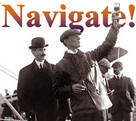
 Up
Up 
 Wagging
Wagging
Its
Tail

(You are here.)
 Down
Down




  Need
to Need
to
find your
bearings?
Try
these
navigation aids:
If
this is your first
visit, please stop by:
Something
to share?
Please:



|
|
Available in Française, Español, Português, Deutsch, Россию,
中文,
日本, and others.
 he brothers were back in Kitty Hawk by the end of August 1902. Their new glider
was a biplane with roughly the same wing surface area as the 1901 machine, but the
similarities ended there. The wing span was ten feet longer and the chord two feet shorter
than the older machine, making the glider look not just larger, but also more graceful.
The wing camber followed a shallow parabolic curve, that of air foil No. 12
from their wind tunnel tests –
this was the most efficient wing shape they had found, with the
highest lift-to-drag ratio. The elevator was extended farther
out in front of the pilot. This gave it more leverage, which translated into better
control. Finally, the brothers decided to replace the tail they had
abandoned in 1900. The 1902 glider had two
fixed vertical surfaces behind the aircraft. Wilbur and Orville calculated that these would help prevent the
unwanted yawing and skidding that occurred when they warped the wings
of their 1901 glider. he brothers were back in Kitty Hawk by the end of August 1902. Their new glider
was a biplane with roughly the same wing surface area as the 1901 machine, but the
similarities ended there. The wing span was ten feet longer and the chord two feet shorter
than the older machine, making the glider look not just larger, but also more graceful.
The wing camber followed a shallow parabolic curve, that of air foil No. 12
from their wind tunnel tests –
this was the most efficient wing shape they had found, with the
highest lift-to-drag ratio. The elevator was extended farther
out in front of the pilot. This gave it more leverage, which translated into better
control. Finally, the brothers decided to replace the tail they had
abandoned in 1900. The 1902 glider had two
fixed vertical surfaces behind the aircraft. Wilbur and Orville calculated that these would help prevent the
unwanted yawing and skidding that occurred when they warped the wings
of their 1901 glider.
From it’s first test flight as a
kite, it was evident that their new glider was vastly superior to their two previous
machines. The amount of lift produced by the new wing design was very close to what the
brothers predicted from their wind tunnel tests. Within a few weeks, they were making glides of over
300
feet (90 meters). Orville flew for the first time on 20 September 1902. As Wilbur had done with earlier machines,
he smashed up the glider in a spectacular crash, resulting in "a heap of flying
machine, cloth, and sticks…with me in the center without a scratch or a bruise."
But it took more than a crash to discourage the brothers at this point -- they put the
glider back together and kept on flying.
Will and Orv began to think about the possibility of "soaring"
flight. They knew that the wind blew upslope when it met a dune.
They carefully observed birds who took advantage of these upslope
winds, riding them to higher altitudes without flapping a wing.
Gulls, osprey, and other native birds could soar for hours expending
very little energy. They simply rode the air currents, finding a
rising wind that would lift them up whenever they got too close to
the ground.
The brothers reasoned they could do the same provided two
conditions. First, their angle of descent (now called a glide
slope) had to be equal to or less than the slope of the rising
wind. Second, the wind had to blow upslope at least as fast as the
minimum speed at which the glider flew. Theoretically, if their
airspeed and glide slope matched the slope and speed of the rising
wind, they could stay aloft indefinitely
– the glider would appear to
hover over the same spot without losing altitude. The first step was
to keep the glider pointed into the wind as they flew.
But they were thwarted in this simple task by a persistent
problem. The glider still skidded when they warped the wings, yawing
toward the wing tip with the highest angle of attack. The tail did little to stop
it; in fact, Orville suspected it actually aggravated the problem by
presenting a broad surface to the airstream when the plane was
skidding and causing it to yaw even more. In some instances, when
the glider was traveling just above its stall speed (the speed at
which it stopped flying), the airplane would quickly and
unexpectedly roll and yaw toward the wing with the highest
angle of attack and smash into the sand.
This reminded the brothers of something they had done earlier.
When they had arrived in Kitty Hawk in 1901, and then again in 1902,
they had sunk a well by hammering lengths of pipe into the sand
until the end of the pipe was below the water table. The way the
glider hammered itself into the sand recollected this
"well-digging."
Thinking it through, Orville determined that the glider behaved this way
because the portion of the wing with the highest angle of attack was also
producing more drag than the rest of the wing. The drag slowed and stalled
one end of the wing in the airstream while the other end kept flying. With
one end stalled, the wing rolled, yawed and crashed, all because of the
unequal drag.
The brothers could avoid digging wells if the
fixed tail was transformed into a movable rudder with its own separate control. This
would allow the pilot to adjust its angle in the airstream whenever he
needed to roll the aircraft. The rudder would counteract the unequal drag,
prevent the unwanted yaw, and keep the entire wing flying
straight ahead at the same airspeed from wingtip to wingtip. No skidding,
no well-digging. Wilbur
accepted Orville's idea, but suggested the pilot already had enough to do without another
control. Instead, the brothers coupled the wires that turned the rudder to the wing
warping mechanism.
This was the last piece of the control puzzle. The movable rudder made the 1902 Wright
glider the first aircraft capable of being precisely balanced in flight. The wing warping
controlled roll, raising or lowering a wing. The elevator controlled pitch, turning
the glider’s nose up or down. And the rudder controlled yaw, moving the nose
left or right. So basic was this breakthrough that every aircraft (and spacecraft!) flying
today still uses the same fundamental roll, pitch, and yaw controls.
About the same time the Wrights added a rudder to their glider, guests
began to arrive. The 1902 Kitty Hawk camp quickly became a crowded, busy place. The Wright’s brother
Lorin
turned up unexpectedly, his curiosity having been aroused by their letters home.
Octave
Chanute and
George Spratt visited again, along with another of Chanute’s aeronautical
acquaintances,
Augustus Herring. Herring was the co-designer and builder of the 1896
biplane glider that had inspired the Wright’s own design.
Chanute and company brought with them a folding tri-plane glider
designed by Chanute and built by Charles H. Lamson, a maker of
man-carrying kites residing in Long Beach, California. Chanute had
offered the glider to the Wright brothers in exchange for testing
it, but they had declined, claiming they had their hands full with
their own experiments. So Chanute had brought Herring to be the test
pilot.
The Lamson glider was a humiliating failure, barely able to glide 50 feet
(15 meters). The Wrights were consistently flying between 300 and
400 feet (90 and 120 meters). The Lamson glider was tested for only
a day, then abandoned. Herring left shortly thereafter, understandably jealous of the Wright’s success. The remaining visitors
helped the brothers launch their craft again and again, sometimes making over
75 flights
in one day.
Chanute also brought with him interesting news of Samuel Langley.
The U.S. Army, who was financing the research and development of the
Great Aerodrome, was growing tired of Langley's delays
– they had initially expected
him to fly in 1901. The Army gave him until 1903 to demonstrate the
Aerodome or they would withdraw their support of Langley and his
team at the Smithsonian.
The best flying came in late October, when their visitors left. Wilbur made a
glide covering 622 feet; Orville’s best was 615 feet. But they also
considered what Chanute had told them about Langley. Will and Orv
had grown tremendously as both engineers and pilots in just a year's
time. They had gained considerable knowledge and experience in
designing and building airplanes and well as unique skills in flying
them. Three years ago, the brothers would never have thought they
might beat the great Dr. Langley into the air, but now...there was a
possibility. On 24 October 1902, the Wright brothers
conducted their first experiment directly related to powered flight.
When they had warped their gliders' wings before, the wings twisted
all along their span. But in this experiment, Will and Orv rigged
the control system so just the wingtips twisted
– the center section of the
glider remained rigid as it would have to do if there was an engine
and drive train mounted in the aircraft. The Wrights wanted to see
if they could effectively roll the glider with just the wingtips.
And they could.
Will and Orv packed up and left for Dayton. The soaring adventure
was set aside as the Wrights re-focused their efforts on being the
first to successfully fly a powered aircraft. The race was on.
|
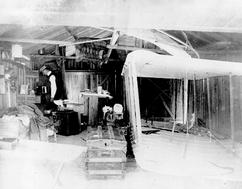
Arriving at Kitty Hawk on 27 August 1902 --
quarters were initially crowded by the 1901 glider until it was
dismantled. The struts and other parts were recycled in the 1902 glider.
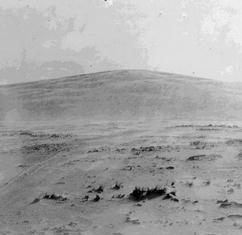
The Wright camp was at the base of Kill Devil Hills, south of Kitty
Hawk. This is the view of the Big Hill from the camp.
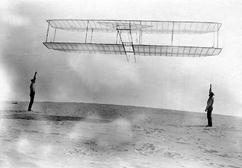
As in 1900 and 1901, on of the Wrights' first experiments with their
1902 glider was to fly it as a kite to measure the lift and drag it
produced.
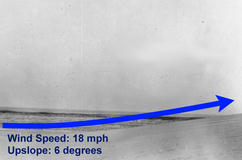
The Wright brothers were hoping to soar in a rising wind. Where the
wind met the base of the dunes, it followed the dune contour
upslope.
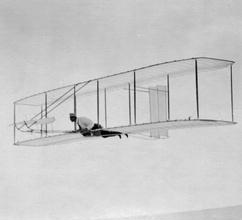
For the first time, the Wright brothers added a tail to their
glider -- two flat, fixed panels. These were intended to keep the
glider pointed forward and prevent the nose from hunting or "yawing"
off course. It did not work.
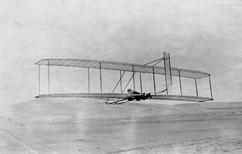
To counteract this "adverse yaw," the Wrights converted the fixed tail
into a movable rudder. The rudder turned in the direction of the
wing producing the least lift, creating an aerodynamic force that balanced the excess drag from the
other wing.

Guests began arriving 1 October 1902. From left to right, this photo
shows Octave Chanute, Orville, Wilbur, Augustus Herring, George
Spratt, and Dan Tate (a local "banker" the Wright hired to help with
launches and other chores). The Wrights' older brother Lorin also
came for a visit – he snapped this photo.
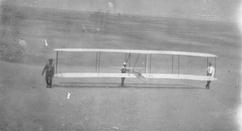
To launch the 1902 Wright glider, the first order of business was to
carry it up a sand dune. This was less work than it looks to be. The
crew turned the glider to face the wind and let it fly uphill. If
the wind was sufficiently strong, the glider dragged the crew along.
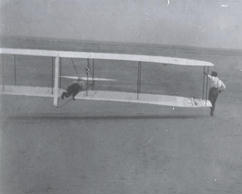
When the pilot was ready, the crew ran the glider forward into the
wind. The pilot adjusted the forward elevator, searching for the
neutral position where the nose was neither rising or falling.
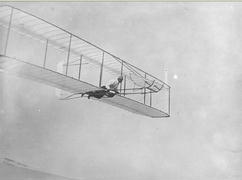
When the pilot was certain he had sufficient airspeed to maintain
flight, he sailed out from the dune and increased altitude, but
usually no more than 10 to 15 feet (3 to 4.5 meters) above the
ground. Here Wilbur flies out from a dune. The abandoned Lamson glider can be seen resting on the sand in the bottom left
hand corner of the photo.

On this flight, the pilot traveled west
– the wind was blowing from west to east. You can see the
buildings of Kitty Hawk off the pilot's right wing.
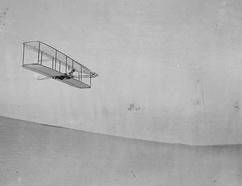
Upon at the base of the dune, the pilot raised the nose to level out
and tried to "stretch" his flight as long as possible.
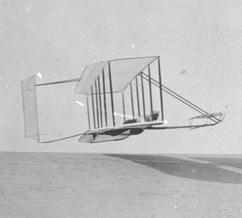
Once he got within a few inches of the ground, however, the pilot
intentionally stalled the glider to land it. He raised
the nose gently until he felt the machine begin to slow.
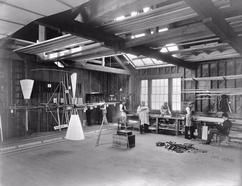
Samuel Langley built the Great Aerodrome in the Smithsonian
Aeronautical Laboratory. This modest workshop with its small team of
craftsmen, engineers, and scientists would later evolve to become
NACA and finally NASA.
|
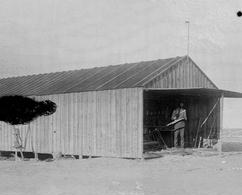
The hangar was in bad shape; storms had washed away the sand
at one end so it drooped almost two feet. But the Wrights shored it up
and enlarged the building to accommodate the new, larger glider.
They also sank a new well -- note the pump.
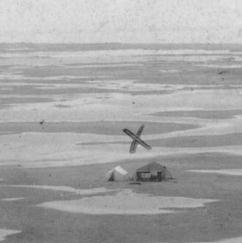
And this is the view of the camp from the top of the Big Hill. The
tent provided extra living quarters for the guests that visited the Wrights
during the 1902 flying season.
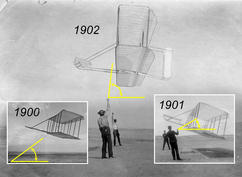
The Wrights calculated the lift-to-drag ratio of a glider design by
measuring the angle of the tether ropes to the horizon. The larger the
angle, the higher the lift in proportion to the drag. Note the huge
angle at which the 1902 glider kited in relationship to the 1900 and
1901 gliders.
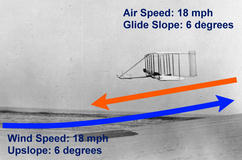
Theoretically, if the glider flew at the same speed as the wind and
descended at the same rate that the wind rose, it could stay aloft
indefinitely flying above the same spot in the sand. This was soaring.
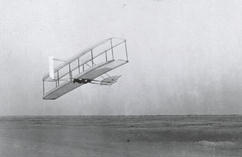
When the glider rolled to one side, the pilot warped the wings to increase the lift on the low
side and bring the wing up. But this also increased the drag on the low
side and cause the glider to yaw in the direction of the wing that
was producing the most lift.
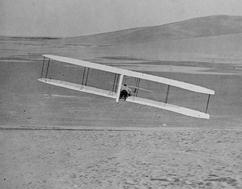
Here the glider has dropped its right wing and Orville is warping the
wings to increase lift on the right side, trying to bring the wings back
to level. But he is also producing more
drag on the right. The rudder is angled toward the left, creating a force to oppose the drag and keep the glider pointed
straight ahead.
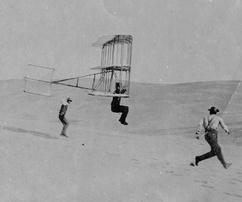
Chanute had designed a triplane glider with "oscillating wigs" and had
it built by Charles H. Lamson. He offered it to the Wrights if they would test it for him. They
declined, and so Augustus Herring made a few glides. Its performance was
poor when compared to the Wright glider.
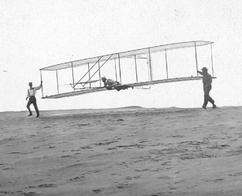
At the top of the dune, the pilot lay down in the cockpit and two crew
– one on either side -- picked the glider up. At this point the glider
was already flying in the wind; the crew simply guided it during the
launch.
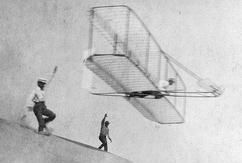
Upon reaching the crest of the dune, where the ground sloped steeply
down, the launch crew released the glider. The pilot angled the elevator
down slightly to lower the nose and increase airspeed.

The direction of flight depended on the wind. The Wrights rarely
turned in the air; their goal was to keep the glider pointed into the wind
and the air flowing over the wings. Here Wilbur is flying north
– you
can see the camp in the distance.
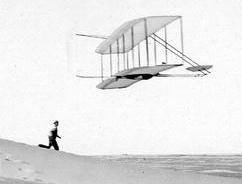
The glider cruised at 18 to 20 miles per hour (29 to 32 kph) airspeed.
Often the wind was blowing 15 mph (24 kph) or better, so the groundspeed
of the aircraft was only a few miles (or kilometers) per hour. Here Dan
Tate trots along under the glider as Wilbur flies.

This was a tricky maneuver. If the pilot raised the nose too high in an
attempt to stretch the flight, the airspeed would bleed off, the glider would
"stall" (lose all lift) and drop to the ground.
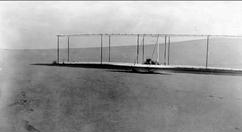
Holding the nose in this attitude, the pilot let his airspeed decrease
until the glider lost all lift and dropped into the sand, skidding
forward a short distance.
|